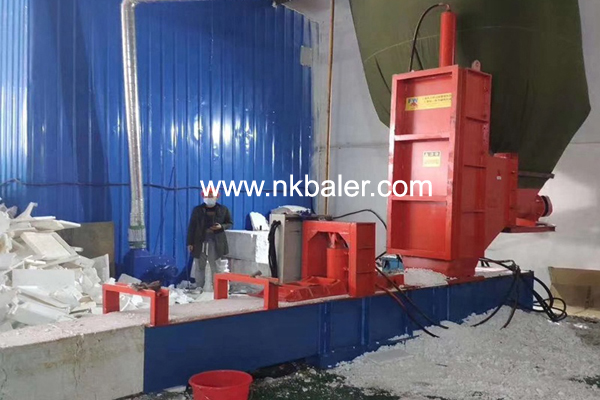Scrap foam press machine is a specialized piece of equipment designed to compress and compact Styrofoam or other types of foam waste into smaller, more manageable forms.Here’s a detailed description of its components and operations:Components:Feed Hopper: This is the entry point where shredded foam or foam offcuts are fed into the machineThe hopper often has a wide opening to accommodate large volumes of material.Pressure Chamber: Once the foam enters the machine, it moves into the pressure chamberThis is a robust, enclosed space where high pressure is applied to compact the foam.Piston/Pressing Plate: Inside the pressure chamber, a piston or pressing plate compresses the foamThe piston is typically powered by a hydraulic or mechanical system, depending on the machine’s design.Hydraulic System: Many foam press machines use a hydraulic system to generate the force needed to compress the foamThis system includes hydraulic pumps, cylinders, and sometimes accumulators to ensure consistent pressure.Ejection System: After compression, the foam block must be removed from the machineThis is often done using an ejection system, which might push the block out from the side or bottom of the machine.Control Panel: Modern foam press machines are equipped with a control panel that allows operators to control the machine’s settings, such as compression time, pressure, and ejection.Safety Features: To protect operators, foam press machines are equipped with various safety features, including emergency stop buttons, interlock switches, and protective guarding around moving parts.Operation:Foam Preparation: Before feeding into the press, foam waste is typically shredded into smaller pieces to make it easier to handle and to ensure a more uniform compression.
Loading: The prepared foam is loaded into the feed hopperDepending on the machine’s design, this can be done manually or automatically.Compression: Once the foam is inside, the pressing plate/piston activates, applying high pressure to compress the foamCompression ratios can vary significantly, but it’s common to reduce the volume to about 10% of its original size.Forming: Under pressure, the foam particles fuse together, forming a dense block. The compression time and pressure determine the density and size of the final block.Ejection: After reaching the desired compression, the block is ejected from the machineSome machines might have automatic cycles that include compression and ejection, while others may require manual operation for this step.Cooling and Collection: The ejected blocks are typically hot and may need some time to cool before they can be handled safelyThey are then collected for storage or transport.Cleaning and Maintenance: To maintain efficiency and safety, regular cleaning and maintenance of the machine are essentialThis includes cleaning residual foam dust and checking the hydraulic system for any leaks or damage.Advantages:Space Efficiency: Significantly reduces the volume of foam waste, making it easier to store and transport.Cost Savings: Reduced transportation and disposal costs due to the reduced volume and weight of the compressed foam.Environmental Benefits: Encourages recycling and reuse of foam waste, reducing environmental impact.Safety: Reduces the risk of handling loose foam, which can be light and airborne, causing potential inhalation risks.

Scrap foam press machines are crucial for businesses dealing with large volumes of foam waste, enabling them to manage waste more efficiently and responsibly.
Post time: Jul-02-2024